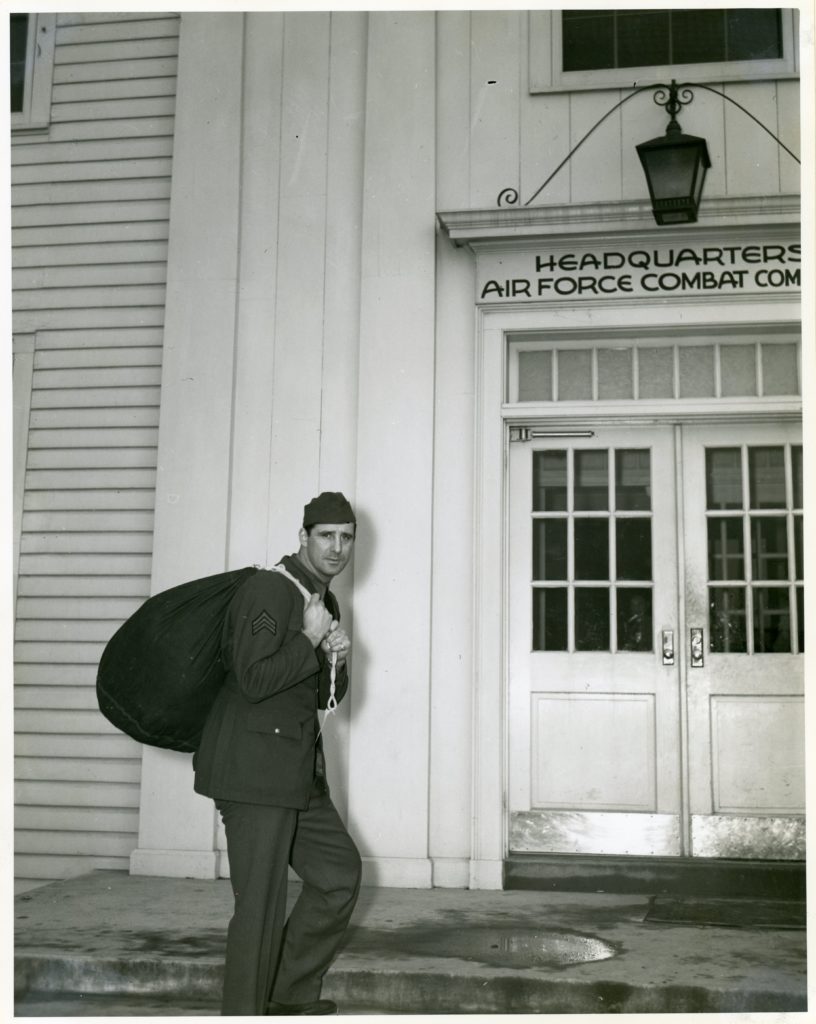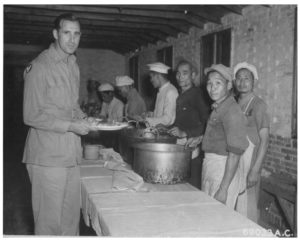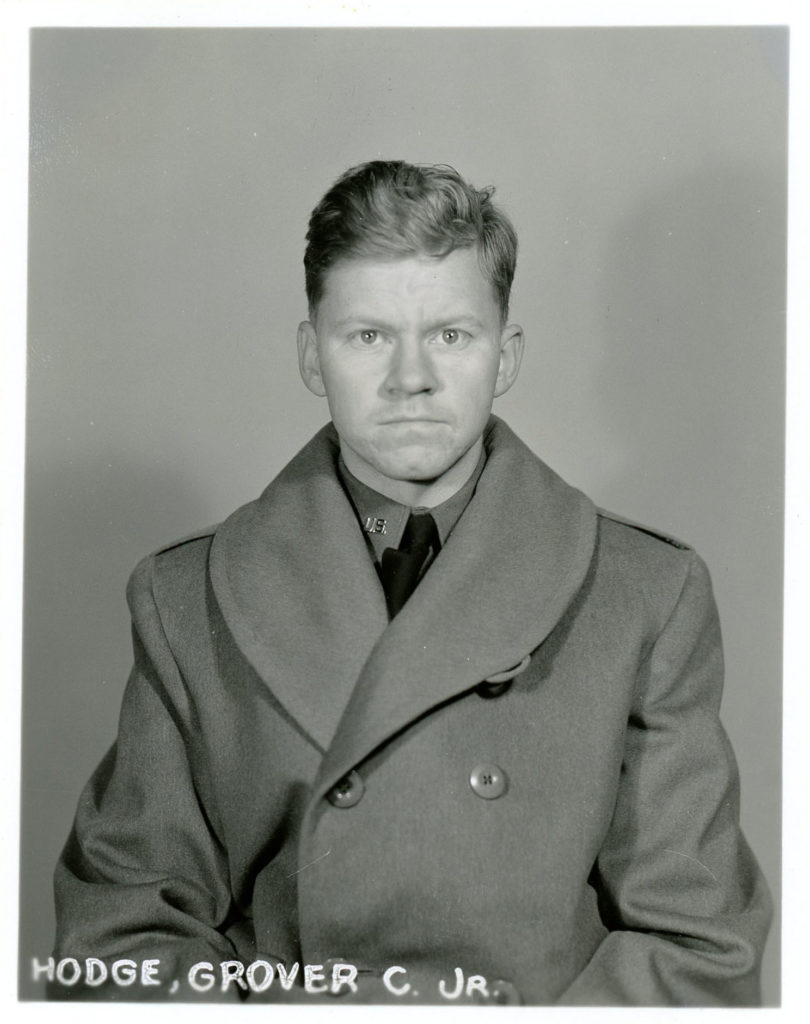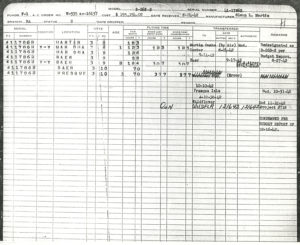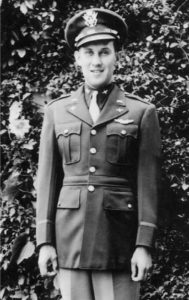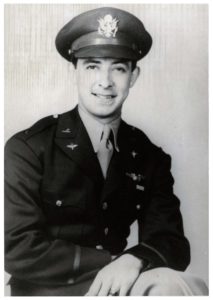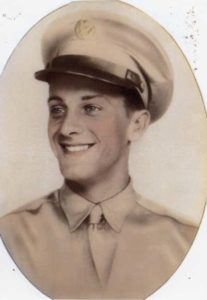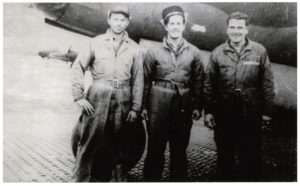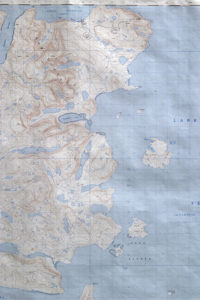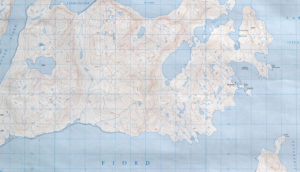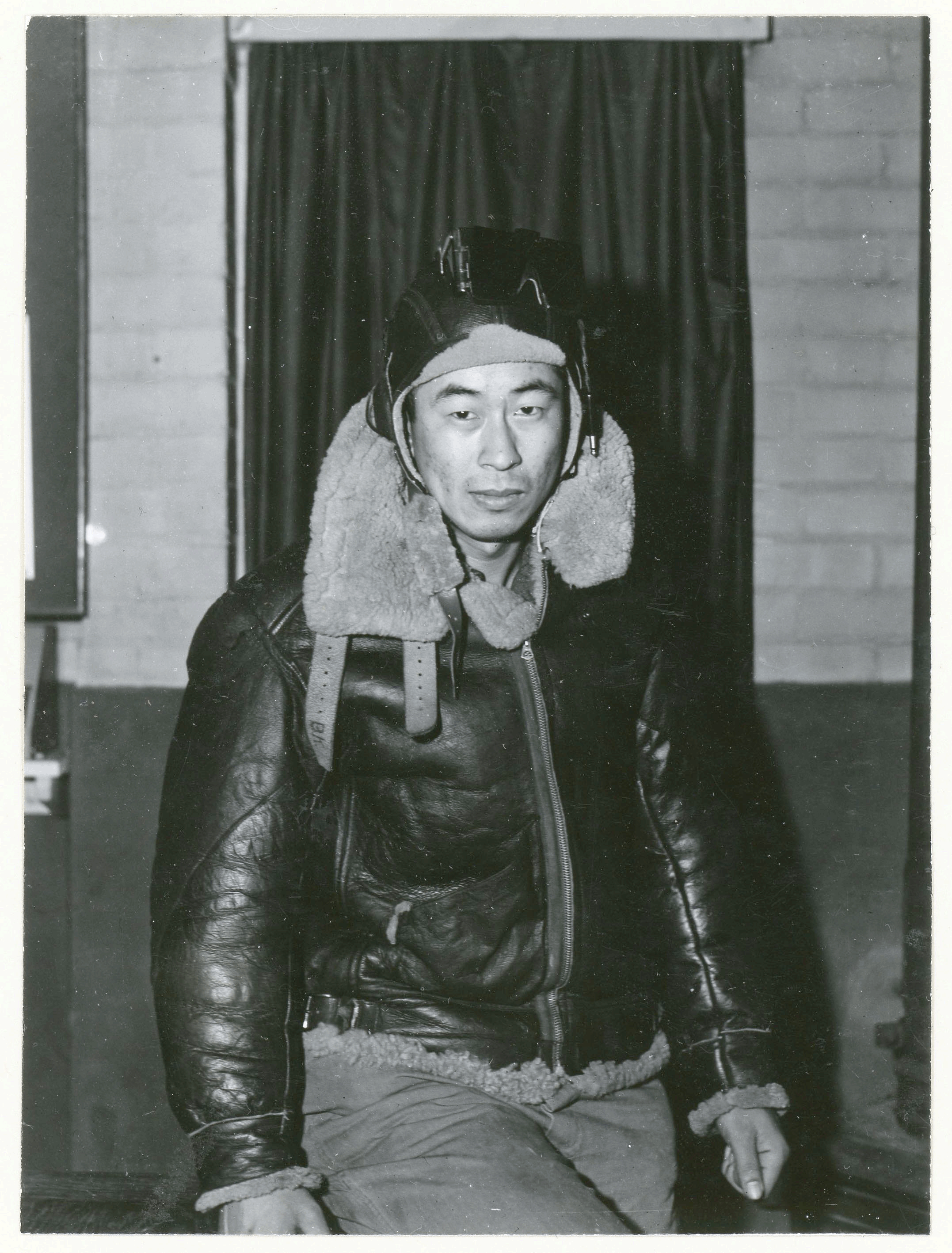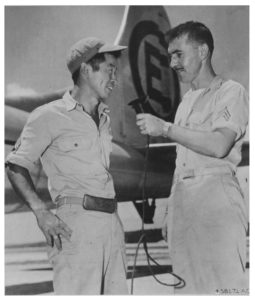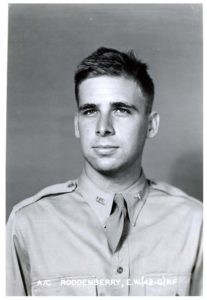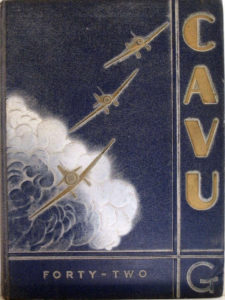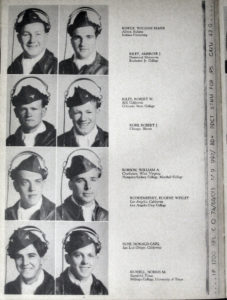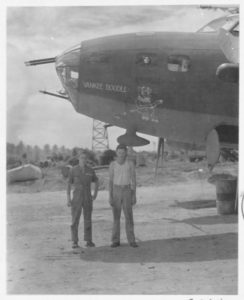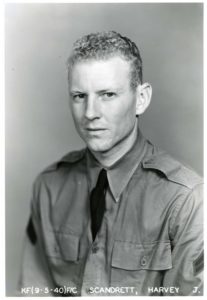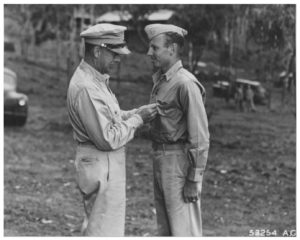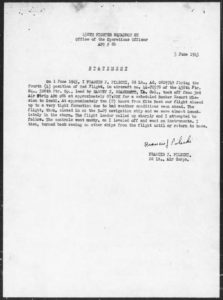The “second” post comprises photos from NARA RG-18 PU, this time of specifically aviators who served in the United States Army Air Force of World War Two…
________________________________________
Hank Greenberg (Henry Benjamin Greenberg)
“Nicknamed “Hammerin’ Hank”, “Hankus Pankus”, or “The Hebrew Hammer”, was an American professional baseball player and team executive. He played in Major League Baseball (MLB), primarily for the Detroit Tigers as a first baseman in the 1930s and 1940s. A member of the Baseball Hall of Fame and a two-time Most Valuable Player (MVP) Award winner, he was one of the premier power hitters of his generation and is widely considered as one of the greatest sluggers in baseball history. He had 47 months of military service including service in World War II, all of which took place during what would have been prime years in his major league career.”
A candid shot of Hank Greenberg in NARA RG-18 PU.
Here’s an official Army Air Force photo of Greenberg, image 69033AC (A2336). Caption? “Captain “Hank” Greenberg, famous baseball personality, pauses a minute before continuing through the chow line at a 14th Air Force base in China.” The actual date of the photo is unknown, albeit text on the photo card states, “Orig. 4×5 neg rec’d 27 August 1946 from 14th Air Force thru AAF Historical Office.” However, VintageDetroit states that Greenberg reenlisted in the Army seven weeks after the Japanese attack on Pearl Harbor, “…accepting a position as a sergeant in the Army Air Force, and a few weeks later he finished officer training school and was commissioned a first lieutenant. He stayed in the uniform of the United States military for the next three and a half years. His last position was in the China/India/Burma Theater of Operations where he scouted bombing targets for B-29s. In all, Greenberg served 47 months in the service during World War II, the longest tenure of any ballplayer.”
Hank Greenberg, at Wikipedia
Hank Greenberg, at FindAGrave
National Baseball Hall of Fame
Video
The Life and Times of Hank Greenberg, at Keith’s (Mr. Sports Historian) YouTube channel
________________________________________
Grover Cleveland Hodge, Jr.
Of the five aviators whose images are presented in this post, the names of two – Hank Greenberg (above) and Gene Roddenberry (see below…) – are known to a lesser or greater degree by the general public, while knowledge of another – Ben Kuroki – is probably limited to WW II aviation buffs, historians of American aviation, and scholars of Japanese American history. But, here’s a fourth personality – or much more aptly and succinctly phrased, a person – knowledge of whom is probably limited only to historians of aviation, those knowledgeable about Canadian history, and (especially?) students of wilderness exploration and outdoor survival: First Lt. Grover C. Hodge, Jr.
Lt. Hodge was the pilot of B-26B Marauder 41-17862, otherwise known as “TIME’S AWASTIN”, an aircraft of the 440th Bomb Squadron of the 319th Bomb Group, which crashed near Saglek Bay, Labrador on December 10, 1942, during a planned flight from Narsarsuaq, Greenland to Goose Bay, Labrador. The plane’s compliment of seven crewmen (including Hodge) survived the crash-landing entirely uninjured. But alas, they did not survive.
A few links to information about this story are given below.
Grover C. Hodge, Jr., at FindAGrave
B-26B 41-17862, at Aviation Safety Network
Here’s the accident report for B-26B 41-17862: Accident Report 43-12-10-501. Note that relatively little of the report focuses on the fate and experience of the crew between the time they crash-landed, and, their discovery by an Eskimo several months later. Instead, most of the document is comprised of descriptions of flight activity on December 10, and, weather conditions.
Grover C. Hodge, Jr.’s Diary, at B-26.com
Saglek Airport, at Wikipedia
Crash in the Wilderness, at The DEWLine
Clarence Simonsen has done extensive research about the loss of 41-17862, his lengthy write-up exploring the event in great detail, with tact and sensitivity. He presents the intriguing (and haunting) possibility that Janssen, Josephson, and Nolan may actually have survived their life-raft journey along the Labrador coast, landed in the vicinity of Nain, and hiked into the Canadian wilderness for an unknown distance. Well, we’ll never know. His essay about 41-17862 is “Smilin’ Jack and the “Twin Engine Queenie”, while his blog is “Preserving the Past II – 50 Years of Research About Aviation“)
Oyster, Harold E., and Oyster, Esther M., The 319th in Action (Records of the 319th Bombardment Group as Recorded by Lieutenant William B. Monroe, Jr., Public Relations Officer, and Others), 1976
____________________
Here’s the Historical Record card for B-26B 41-17862. The aircraft was received by the Army Air Force on August 24, 1942.
____________________
Here are images of three of TIME’S AWASTIN’s crew members. For those who already know this story (and others who have yet to become familiar with it), Janssen and Josephson (with Sgt. Charles F. Nolan, a passenger) left the crash site in the aircraft’s life raft on December 23, in search of help; in search of anything. The three men – alluded to just above; their fate yet and perhaps forever unknown – were never seen again. Their names are engraved upon the columns of the East Coast Memorial, in Manhattan.
Co-Pilot: 2 Lt. Paul W. Janssen, at FindAGrave
Tribute page by Mrs. Bernice Ulrich, at National WW II Memorial
____________________
Navigator (Bombardier): 1 Lt. Emanuel J. Josephson, at FindAGrave
____________________
Gunner: Cpl. James J. Mangini, Jr, at FindAGrave
Corporal Mangini remained at the crash site with Lt. Hodge, Cpl. Galm (radio operator), and Sgt. Weyrauch (flight engineer).
Tribute page by Mrs. Lorraine Suter, Cpl. Mangini’s sister, at National WW II Memorial
____________________
Here are links to FindAGrave biographical profiles for the three crewman for whom photographs are unavailable:
Cpl. Frank L. Galm, at FindAGrave
Sgt. Charles F. Nolan, at FindaAGrave
Sergeant Russell Weyrauch, at FindAGrave
____________________
The below image, probably taken by Lt. Josephson, shows three unknown aviators standing before an B-26, at an unknown location.
____________________
These two topographic maps, prepared by the Mapping and Charting Establishment, Canadian Department of National Defence (both 1968 editions) are (upper map) “Cape Uivak – Fish Island – Labrador North District (14L/7.8, Edition 2)”, Newfoundland, and (lower map) “Hebron – Labrador South District (14L/2, Edition 1)”, Newfoundland. The scale of the maps is 1:50,000 and the contour interval 100 feet.
Though I haven’t digitally “connected” images of he two maps to one another via Photoshop, you can see that the lower image, showing Hebron, is geographically continuous with and therefore cartographically “connected” to the upper image. As such, what immediately stands out is that a fjord – the Iterungnek Fjord – lies between the peninsula where Hebron is situated (in the “lower” map) and the peninsula where Cape Saglek and Saglek Airport are situated (in the “upper” map), 41-17862’s crash location being in the vicinity of that present-day airport.
As is immediately obvious, though the straight-line “as the crow flies” distance between the Saglek Lighthouse, south-southeast to Hebron, is a little over 20 miles, that relatively short distance does not at all reflect the topography, the nature of the intervening terrain, or especially – when those two factors are weighed in combination – the obvious lack of any direct path between the crash site and Hebron. Also, given the snow cover when 41-17862 crashed in mid-December, the safest (a very relative term) route between the crash site and Hebron would probably have involved following the highly irregular coastline east and south, along the Labrador Sea. Even if this could have been done, such a journey would have entailed the crew hiking a distance far, far beyond a mere 20 miles, and finally, finding some way to cross the Iterungnek Fjord to reach – on the adjacent peninsula – the village of Hebron.
So, even in the very best of circumstances… If the crew definitely knew their position; if they were all uninjured (well, they were uninjured to start; that’s true); if they were in good health (they seemed to have been in good health, to start); even if they had wilderness training and experience in outdoor survival during winter months in the Canadian North, the prospect of reaching Hebron – in the dead of winter over snow-covered terrain, or, along an icy coastline – would I think have been far more daunting than initially apparent from viewing small-scale maps of the area.
Dating from November of 2010, here’s a song; a ballad – with kind of an air of Gordon Lightfoot’s The Wreck of the Edmund Fitzgerald (in which you know the outcome of the story beforehand, wish that the outcome would have been entirely different, yet are still “drawn” to the story by its haunting and symbolic nature…) about the crew of “TIME’S AWASTIN”, by Ellis Coles, at the YouTube channel of Traprocker123. The song is based upon the diary kept by Grover Hodge from October 15, 1942 through February 3, 1943, while its title, “Diary of One Now Dead”, may (?), have been inspired by the title given to the diary transcript as published in The 319th in Action, in 1976, where Hodge’s diary comprises the final section of the book: “DIARY (BY ONE NOW DEAD).”
________________________________________
Ben Kuroki
“The only American of Japanese descent in the United States Army Air Forces to serve in combat operations in the Pacific theater of World War II. He flew a total of 58 combat missions over Europe, North Africa, and Japan during World War II.”
Here’s Ben Kuroki’s quite candid image in NARA RG 18-PU.
In 1985, Ben’s recollections of his experiences in the 20th Air Force appeared in Chester Marshall’s The Global Twentieth – An Anthology of the 20th AF in WW II. A complete transcript of Kuroki’s essay, as well as its accompanying photo, showing Kuroki in the tail gunner’s position, follows…
THE STORY OF DETERMINATION BY A JAPANESE-AMERICAN TAIL-GUNNER
By Ben Kuroki, Tail Gunner 484th Squadron, 505th Bomb Group
Preface
Ben Kuroki was the only Japanese-American to fly combat missions with the Army Air Force in the Pacific Theatre of War during World War II. And he did it only by sheer determination and persistence – going all the way to the top to get permission. A personal letter to him from Secretary of War Henry Stimson struck down the Air Force regulation prohibiting Japanese-Americans from flying combat missions in the Pacific thus allowing Ben to remain a B-29 crew member.
“Influential friends went to bat for me and I was granted an exception which allowed me to be accepted in the 505th Bomb Group as a tail gunner on a B-29,” Ben said. “Army intelligence officers twice tried to remove me from my crew before we departed the U.S. for the Pacific, making it necessary for me to show my special letter from Secretary of War Stimson.”
In preparing this article, I asked Ben if we could publish the letter from the Secretary of War along with his story. Ben replied: “Much to my dismay, I let my daughter use it in an art exhibit at the University of California at San Diego, and since then, we have not been able to find it.”
Chester Marshall
Here’s Ben’s story:
When I returned to the United States after completing thirty missions in B-24’s in the European Theatre, I was sent to Santa Monica, California for rest and recuperation. Because of a few discriminatory actions against me soon after arriving there, I decided to go to any length to get into B-29’s and the Pacific War.
At Santa Monica I was asked to appear on an NBC radio program featuring the noted singer Jenny Simms. My appearance was cancelled because NBC officials said the Japanese-American issue was too controversial. Later, I was in Salt Lake City, and a man refused to share a taxi with me, saying, “I won’t ride with no damned Jap!” This happened while I was in uniform and wearing the Distinguished Flying Cross with oak leaf cluster and other ribbons.
When my assignment came through placing me in the 48th Bomb Squadron, 505th Bomb Group, 313th Bomb Wing, I was a happy soldier again. I was assigned to a B-29 crew as tail gunner. After training at Harvard, Nebraska, we were scheduled to deploy to Tinian Island in the Marianas where we would join in the great air assault then in progress against the Japanese homeland.
Aerial combat was not new to me. I had completed thirty missions – the twenty-five required plus five – as a tail gunner with the 409th Bomb Squadron of the 93rd Bomb Group in Europe. The 93rd Group, the first B-24 Group to be stationed in England, was known as Ted Timberlake’s “Flying Circus.” One of our toughest missions was the historic low-level attack on the Ploesti oil refineries in Romania. That one still makes the hair rise on the back of my neck!
For my upcoming Pacific tour, I was assigned to Crew Number 84-10 as tail gunner. Other members of my crew were: 1st Lieutenant James Jenkins, airplane commander; 1st Lieutenant Harold B. Wilson, pilot; 1st Lieutenant Joseph Pope, navigator; 2nd Lieutenant Kenneth Neill, bombardier; M/Sergeant Paul Hughes, flight engineer; S/Sergeant Warren Sheck, radioman; Sergeant William Shaffer, radarman; S/Sergeant Bernard Endler, central fire control; Sergeant Jerome Karnoff, right gunner; and Sergeant Leroy Kirkpatrick, left gunner.
We named our plane “The Honorable Sad Saki,” which was a sort of take off on the names of the “Sad Sack” cartoon character and a Japanese drink.
My most unforgettable experience came soon after we landed in Tinian. The ground crews had arrived on the island earlier, and rumors were rampant of enemy stragglers infiltrating the camp. Few of our GIs had previously been in combat, and they were extremely trigger happy. After dark they would open up with their carbines and rifles at the slightest noise, sending bullets whizzing all around the camp. The next day they would find dead pigs and other domestic animals that belonged to the natives. These animals, crunching around in the nearby cane fields, triggered a lot of gunfire from our “protectors” and caused us to fear for our lives. Since I was of Japanese ancestry, I was so worried that one of the trigger happy GIs would take a shot at me that I was afraid to even go to the latrine after dark, preferring to anxiously wait for the sun to rise. I felt that I deserved the Purple Heart for bladder damage!
The rumors also indicated that some enemy stragglers were wearing GI uniforms so I stuck real close to my other crew members – even in chow lines during the day.
During the first couple of weeks when the trigger-happiness was at its worst, I actually felt safer when I was flying combat missions over enemy targets. Although the Japanese anti-aircraft fire and fighter opposition were lighter than I had encountered over Europe, no mission was a milk run. When my buddies kidded me about being my bodyguards back at the base, I sorta got even when we were airborne by joking, “You guys had better be good to me, because if we get shot down, you’ll need my help. I’ll even bring you rice and fish heads.”
Ben and his crew completed 35 missions against the Japanese homeland making him one of the elite few who accomplished the feat of completing a combat tour of duty in both the European Theater of operation and the Pacific Theater of operation.
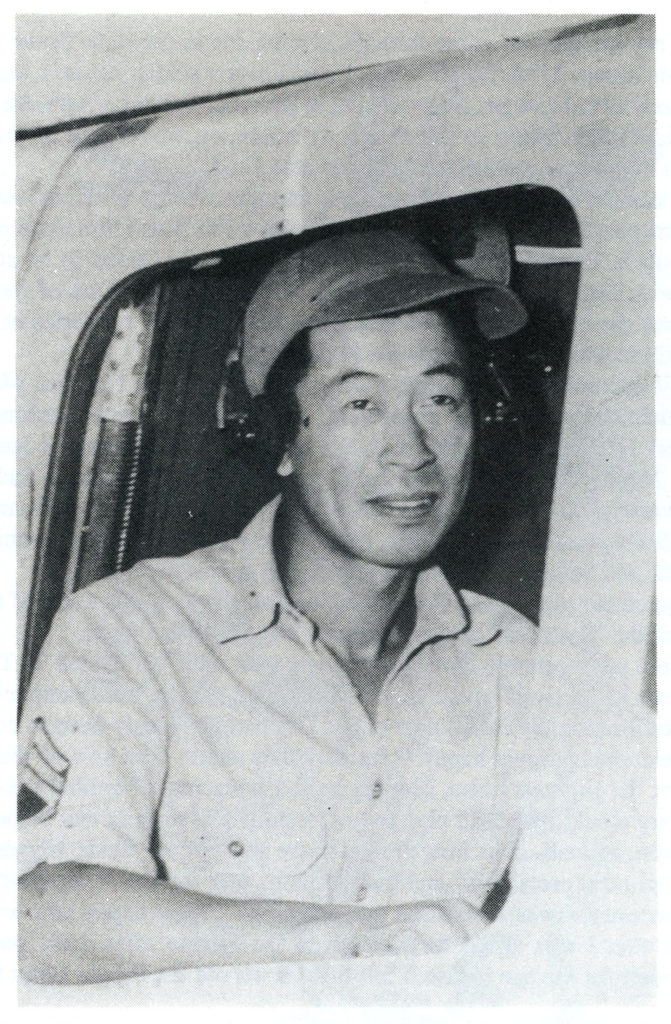
Here’s Ben Kuroki in Army Air Force photo +58171AC (A39047): JAPANESE “AMERICAN TAIL GUNNER OVER TOKYO – American born Japanese T/Sgt. Ben Kuroki, Hershey, Nebraska, a tail gunner with 30 ETO missions, is interviewed on Tinian after completing his 27th mission in the Pacific, by T/Sgt. Hal Brown, Bakersfield, Calif., combat photographer for Gen. H.H. Arnold’s official Army Air Forces weekly radio show, “The Fighting AAF”. Kuroki wears Distinguished Flying Cross and the Air medal with four Oak Leaf Clusters.”
Ben Kuroki, at Wikipedia
Ben Kuroki’s Family Tree
Ben Kuroki, at FindAGrave
American Air Museum in Britain
Ben Kuroki’s Bloot Chit, at National Museum of American History (Behring Center)
And, Chester Marshall’s book…
Marshall, Chester, The Global Twentieth – An Anthology of the 20th AF in WW II, Apollo Books, Winona, Mn., 1985
Here’s a snippet of what is (presumably?!) a much lengthier interview of Ben Kuroki, via the National Japanese American Historical Society.
________________________________________
Gene Roddenberry (Eugene Wesley Roddenberry)
“Television screenwriter, producer and creator of Star Trek: The Original Series, and its sequel spin-off series Star Trek: The Animated Series and Star Trek: The Next Generation.”
Gene Roddenberry, long before the advent of Star Trek, in his photographic portrait from NARA RG-18 PU. Note the white-ink label at the bottom of the photo with the abbreviation “(42-G) KF”. Though I think (?) that would imply graduation from Class 42-G at Kelly Field, Roddenberry actually graduated with Class 42-G at Goodfellow Field, San Angelo, Tx. …
… and, via Army Air Forces Collection, here’s the front cover of his class graduation book, CAVU, Class 42-G, Goodfellow Field, San Angelo, Tx. …
… where his portrait appears on page 69.
As described at Pacific Wrecks, Roddenberry served in the Southwest Pacific with 394th Bomb Squadron of the 5th Bomb Group, eventually retiring from the military with the rank of Captain.
On August 2, 1943 he piloted a B-17E Flying Fortress – 41-2463, “Yankee Doodle” – which crashed on takeoff from Guadalcanal or Espiritu Santo, with the loss of two crew members, Sgt. John P. Krueger and navigator 1 Lt. Talbert H. Wollam. The aircraft can be seen below in Army Air Photo Photo 22847AC (A45620). Caption follows:
“B-17E – “Yankee Doodle”
“Members of a heavy bombardment squadron in the South Pacific have a novel method of chalking up their victories. On the noses of their B-17s they paint Jap flags to indicate planes shot down. Some have downed as many as 15 zeros.
Miniature destroyers or cruisers or transports signify a ship of that class officially sunk. The torpedoes indicate the number of striking missions in which the plane has had a part. A striking mission in the combat area is an attack on a specific enemy target.
Standing under the nose of their Flying Fortress, these two men [names unknown] of the ground crew pause to pose for the Army photographer in the South Pacific. These men are extremely proud of their planes and their victories. Note the string of shells for the machine gun in the nose.”
“Rec’d 1/9/43 thru Director of Photography from South Pacific Theater. Copied 2/16/43.”
Gene Roddenberry, at Wikipedia
Gene Roddenberry, at FindAGrave
B-17E 41-2463 – 13th Air Force, 5th Bomb Group, 394th Bomb Squadron, (Lost August 2, 1943)
Talking About Gene Roddenberry, at Television Academy Foundation
Internet Speculative Fiction Database
________________________________________
Harvey Jackson Scandrett
“The sun glinted off the fuselages of the silvery Mustangs and from my vantage point, they seemed to stretch to the horizon to the front and sides of me. Between 350-400 miles north of Iwo we ran into a gigantic weather front with a solid squall line of cumulonimbus clouds blocking our path. These immense thunder-heads were too high for us to surmount. After we had circled for some time looking for holes without finding a trace of any, I heard Col. Scandrett say over the radio “Proceed with the mission; I take full responsibility.” At this my heart stopped and I know that I was not alone.”
“I realize now that Scandrett had to make a difficult decision without benefit of accurate weather information. He gambled and lost everything.” – Leonard A. Dietz, July 6, 1986
Enlisted in the United States Air Force in 1940, graduating from Randolph Field as a fighter pilot. By 1945, commander of the Headquarters Squadron (Deputy Group Commander) of the 506th Fighter Group. On June 1, 1945, commander of the three 7th Air Force Fighter Groups (15th, 21st, and 506th) assigned for B-29 Superfortress escort mission to Osaka, Japan. One of the 24 7th Air Force P-51 pilots lost that day.
One of the links below will take you to a PDF with the names of the 24 pilots lost on this mission, as well as the three other pilots who – having parachuted over the Pacific Ocean – were rescued. The list also includes aircraft serial numbers and MACR numbers for the aircraft flown by the 24 pilots who didn’t survive. The only similar incident that I’m aware of from the European Theater involved the loss of eleven P-51B Mustangs and pilots – no survivors – of the 363rd Fighter Group (five from the 381st Fighter Squadron, and six from the 382nd) over the English Channel on March 4, 1944, almost certainly caused by a combination of pilot inexperience and (very) bad weather.
Regarding 7th Air Force P-51 losses on the June 1, 1945, mission, unfortunately, aircraft nicknames and plane-in-squadron numbers are known for only a few of these P-51s (and this, it seems, only from private photographs!), for MACRs filed for 7th Air Force fighter losses did not record such information. To be specific, the “space” for aircraft nicknames in such MACRs doesn’t include the individual planes’ actual hand-painted-and-sometimes nose-arted nicknames, the simple and generic word “Mustang” appearing in that data field instead. (?!?)
Missing Air Crew Report 14653
Harvey J. Scandrett, at FindAGrave
Harvey J. Scandrett, at Pacific Wrecks
7th Air Force P-51D Pilot Losses – June 1, 1945
P-51D 44-72607, Madam Wham-Dam / 550 – 7th Air Force, 506th Fighter Group, 458th Fighter Squadron (Lost June 1, 1945), at Pacific Wrecks
506th Fighter Group – Iwo to Japan
506th Fighter Group – 1 June 1945 Black Friday
A book! (A good book, at that…)
Lambert, John W., The Long Campaign – The History of the 15th Fighter Group in World War II, Sunflower University Press, Manhattan, Ks., 1982 (see pages 121-126)
A magazine (…from years ago…)
Blake, Steve, “The 363rd Fighter Group in WW II – Part I”, Fighter Pilots in Aerial Combat, Summer, 1982, Number 5 (pp. 15-22)
